Isfahan's Atiq Square | A Historical Crossroad
Atiq Square, also known as Isfahan Kohneh Square, Sabze Meydan or Imam Ali Square, is a historic landmark in Isfahan, Iran. Located in the city center, it's a popular tourist destination.
Atiq Square's history stretches back to the Seljuk period, when it was a thriving commercial center. It served as a crucial connection point between Isfahan's Jame Mosque, the Haruniye building, the Kasegaran school and caravanserai, and the city's Grand Bazaar.
The construction of the nearby Naqsh-e Jahan Square, however, shifted the city's focus. The market activity at Atiq Square gradually declined. In recent years, authorities have undertaken restoration efforts to revitalize the square. These efforts include the introduction of a new market, aiming to restore its past vibrancy and make it a valuable historical attraction for visitors.
Interested in visiting Isfahan's Atiq Square?
Check out our Isfahan tour packages to find an itinerary that includes visiting the square
or...
Design your own tailor-made itinerary and include Atiq Square in it by yourself, today!
History of Atiq Square
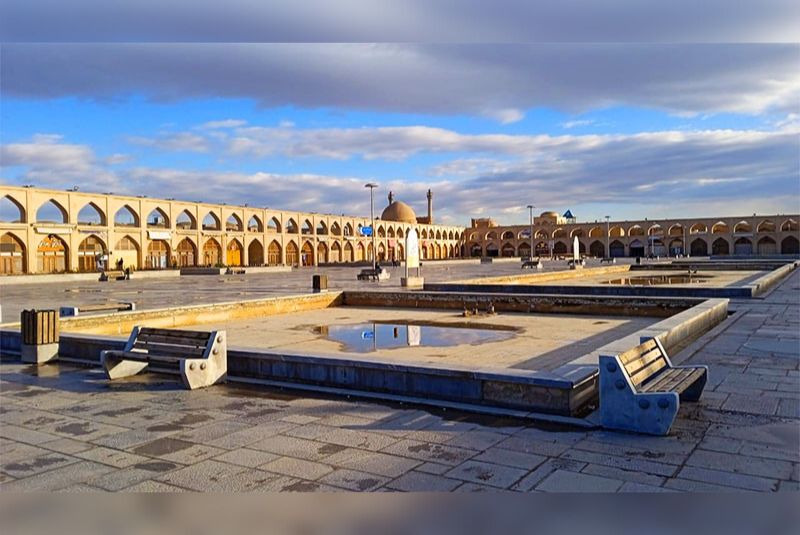
Atiq Square boasts a long and fascinating history, dating back to the Seljuk era (1037-1194 AD). During this period, Isfahan served as the capital of the Seljuk Empire. Khwaja Nizam al-Mulk Tusi, a prominent Seljuk minister, oversaw the development of Atiq Square. The square flourished as a major center for commerce and trade.
However, Isfahan's prosperity faced challenges. After the Seljuks, invasions by the Ilkhans (1256-1335 AD) and Timurids (1370-1405 AD) caused widespread destruction throughout the city. Atiq Square likely wasn't spared from this damage.
Despite the destruction, there's evidence that some aspects of Isfahan, including Atiq Square, recovered. Some Mongol leaders, like Timur, were influenced by Islam and perhaps recognized the value of the city's rich culture. This may have led to some rebuilding efforts, although the extent of this remains unclear.
The construction of Naqsh-e Jahan Square in the 17th century under Safavid rule (1501-1736 AD) marked a significant shift. The existing Atiq Square, possibly still recovering from past invasions, couldn't meet the needs of the expanding Safavid capital. Shah Abbas I, the Safavid Shah, addressed this by constructing the magnificent Naqsh-e Jahan Square nearby. Consequently, Atiq Square became known as the "Kohneh Square (Old Square)," with its commercial activity reduced.
Despite the challenges, Atiq Square remains a vital part of Isfahan. Its strategic location and historical significance continue to draw visitors. The ongoing restoration efforts aim to preserve this enduring symbol of Isfahan's past.
| Related: Isfahan Historical Palaces
Isfahan Kohneh Square Architecture

Atiq Square's importance lies not just in its age but also in the surrounding structures. These include governmental, religious, and commercial buildings, reflecting the diverse aspects of Seljuk society.
The square's architectural beauty shines through its night-time illuminations. The interplay of light and cascading fountains creates a captivating atmosphere, attracting both tourists and photographers.
Some of the notable buildings and the monuments around Isfahan Atiq Square include:
1- Risman Bazaar

Risman Bazaar holds a significant place within Isfahan's Grand Bazaar. Located near the Jame Mosque, historical evidence suggests the bazaar's origins date back to the Seljuk period (1037-1194 AD). While details about the Seljuq-era structure are unclear, the current covered market reflects the architectural style of the Safavid period (1501-1736 AD). This suggests the bazaar underwent major renovations during the Safavid era, possibly by a Safavid architect.
The design of Risman Bazaar is simple and traditional. Stepping inside, visitors encounter a marketplace steeped in the cultural, literary, and historical heritage of Isfahan and Iran.
Corners of the bazaar reveal remnants of its prosperous past. The presence of caravanserais, resting places for travelers, and mansions hints at a time when the bazaar bustled with activity, attracting numerous merchants and businessmen.
Despite some changes over time, Risman Bazaar remains a lively and active marketplace. It continues to serve as a reminder of Isfahan's long history as a center of commerce and cultural exchange.
| Related: Isfahan Traditional Bazaars
2- Imam Ali Mosque

The Ali Mosque Minaret stands as a prominent landmark in Isfahan, boasting the title of the city's oldest minaret. Its construction dates back to the 11th century, placing it firmly within the Seljuk era (1037-1194 AD).
Standing tall at 52 meters, the Ali Mosque Minaret is the second highest historical minaret in Isfahan, surpassed only by the Sarban Minaret. While details about the mosque itself are limited, the minaret's enduring presence serves as a testament to the architectural achievements of the Seljuk period.
| Discover: Elements of Traditional Persian Architecture
3- Sheikh Bahai Hamam
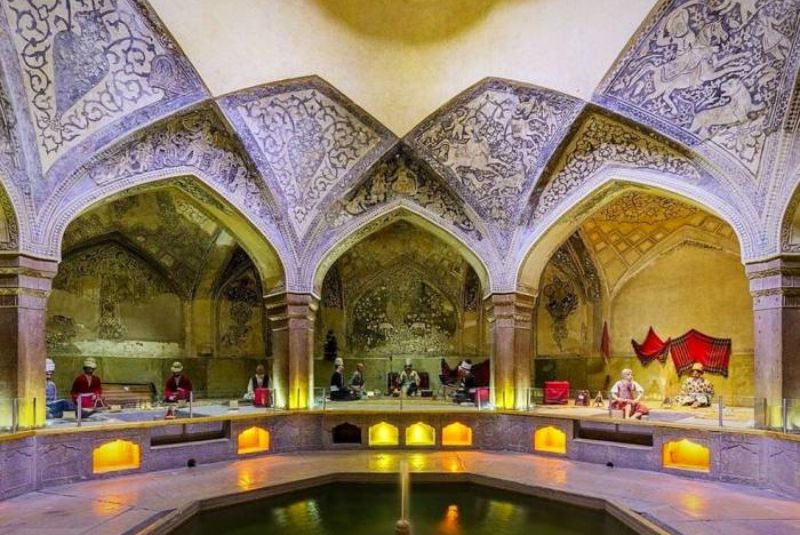
The Sheikh Bahai Hammam (bathhouse) in Isfahan is a fascinating example of Safavid era (1501-1736 AD) engineering and architecture. Sheikh Bahai, a renowned scientist and architect, is credited with its design. The hammam is shrouded in local legends, including the intriguing tale that a single candle kept the entire bathhouse warm.
While the single-candle story is likely a legend, it highlights the innovative heating system that some believe Sheikh Bahai incorporated. Historical accounts suggest the presence of a complex network of clay pipes beneath the hammam. These pipes may have been used to transport sewage from the nearby Jame Mosque. Sewage generates methane gas, and some theories propose that Sheikh Bahai devised a method to capture and utilize this gas as fuel for the bathhouse. This concept aligns with modern practices of generating biogas from sewage.
Another interesting legend surrounds the source of the bath water's warmth. The story claims the water source was lined with gold, a highly conductive metal known for its efficient heat transfer. While the use of solid gold for such a purpose is highly unlikely, it could reflect the use of high-quality copper or another conductive material.
| Also read about: Persian Qanat - Ancient Underground Water Channel
4- Shah Ali Bath
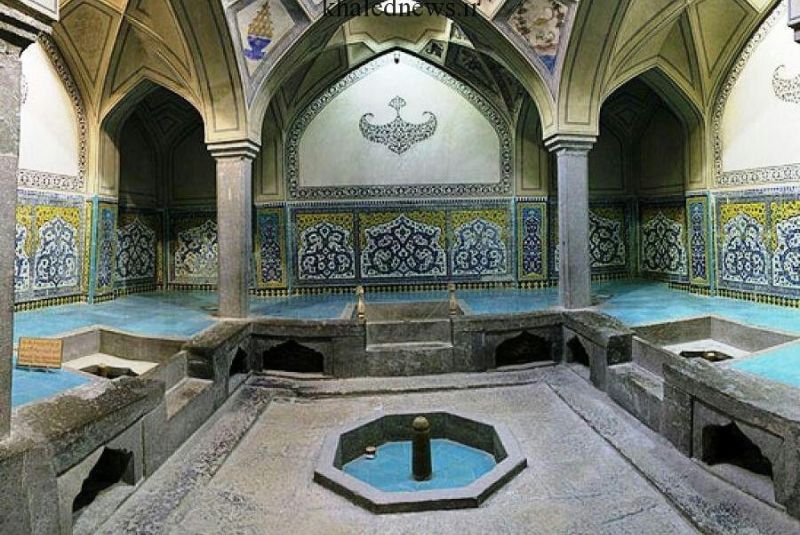
The Ali Qoli Aga Historical Bath, also known as Shah Ali Bath, was built in the early 17th century by Ali Qoli Aga, a courtier of the Safavid shahs. Originally, the bath served the public, offering separate bathing times for men and women. Wealthy patrons could rent the entire hot room for private use.
Over time, the bath's function changed. Restoration efforts and the addition of statues transformed it into an anthropology museum. This transformation ensured the preservation of the bath's historical significance. The Ali Qoli Aga Historical Bath reflects the architectural style of Isfahan during the late Safavid era (1501-1736 AD). The building itself is divided into two separate bath sections, a larger one and a smaller one.
The bath is particularly interesting for its collection of decorative elements. These adornments showcase artistic styles from different periods. Notably, paintings were added during the Qajar era (1789-1925 AD), demonstrating the evolving artistic influences on the bathhouse.
| Also might be interesting: Shushtar Hydraulic System - An Ancient Engineering Wonder
5- Imamzadeh Haroun-e-Velayat

The Imamzadeh Haroun-e-Velayat, located opposite the Ali Minaret in Isfahan, is a crucial structure from the early Safavid era (1501-1736 AD). While the identity of the person entombed there is debated, the complex itself boasts historical significance. Architectural elements like a portico, a tiled dome, and a large yard contribute to its beauty. Further improvements were made during the reign of Fath-Ali Shah, solidifying the Imamzadeh Haroun-e-Velayat's place as a landmark in Isfahan's architectural history.
| Discover: Monar Jonban - The Mystery of Isfahan's Shaking Minarets
6- Nizam Al-Mulk Dome
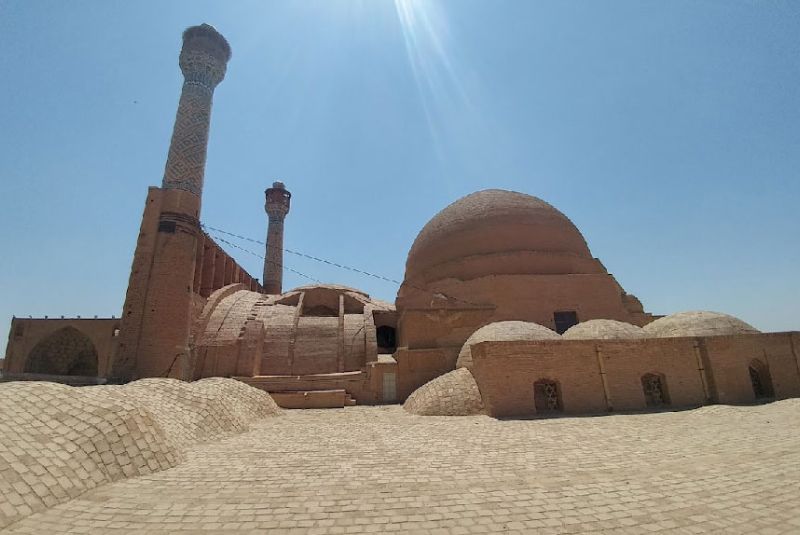
The Nizam al-Mulk Dome, also known as the South Dome, is the crown jewel of Isfahan's Jame Mosque. Built during the early Seljuk era (1037-1194 AD), it stands as a testament to the power and ambition of the Seljuk rulers. Designed with eight ribs and supported by massive piers, it was once the largest masonry dome in the Islamic world, showcasing the Seljuk Sultanate's engineering prowess. The dome's innovative squinch technique, involving a barrel vault placed over two quarter domes, became a blueprint for future mosque designs.
| Read more: Isfahan Mosques You Should Visit
7- The Tombs of Nizam al-Mulk
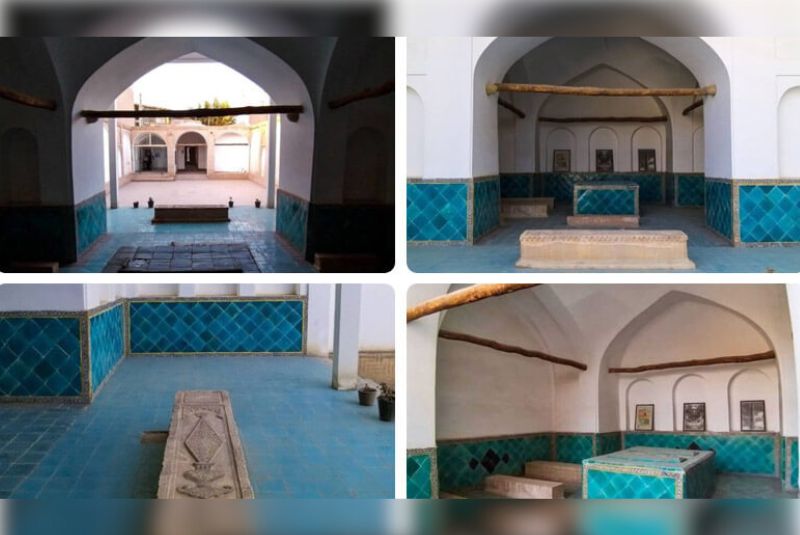
The Tomb of Nizam al-Mulk, located in Isfahan's Ahmadabad quarter, holds the simple gravestone of this powerful Seljuk vizier. Despite his long and influential service (nearly 52 years!), the current marker lacks ornamentation and inscriptions. Interestingly, the tomb also houses the gravestones of Malik-Shah I, the Seljuk Sultan, and his wife Tarkan Khatun. Historical accounts suggest Tarkan Khatun may have played a role in Nizam al-Mulk's murder, adding a layer of intrigue to this shared burial site.
8- Aegean House
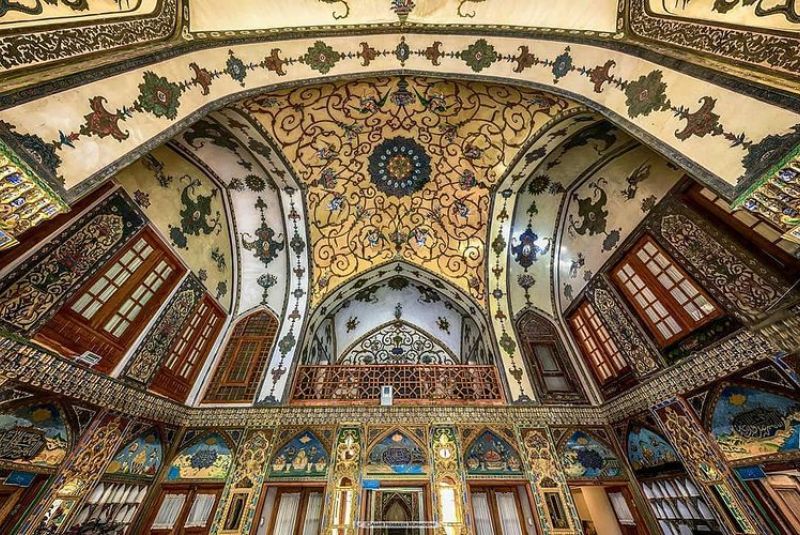
The Aegean House, also known as Harounieh's House, is a historic building in Isfahan, Iran. Though it bears the Aegean family name, none of its members ever resided there.
The house dates back to the Safavid period (1501-1736 AD) in terms of its architectural style, but the decorative elements were added later in the Qajar period (1789-1925 AD). Originally much larger at 2,000 square meters, today the house occupies a significantly reduced area of 530 square meters.
The main hall is a particularly captivating feature. This two-story space boasts a beautifully painted ceiling adorned with figures of angels. The walls themselves are decorated with verses from the Quran, names of revered Imams, and colorful depictions of fruits, birds, and hunting scenes.
| Discover: Best Restaurants in Isfahan
9- Kasegaran School
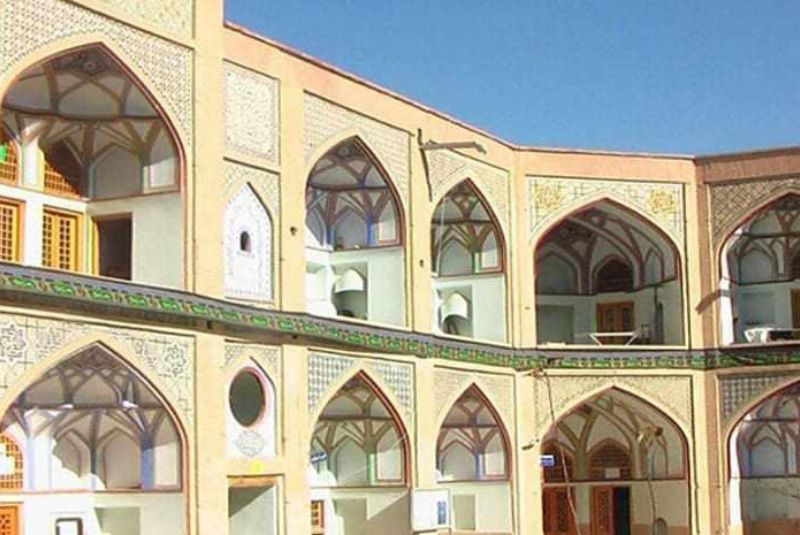
The Kasegaran School, built in 1691-1692 AD by Hakim al-Mulk Ardestani, is a remarkable example of Safavid era (1501-1736 AD) architecture in Isfahan. This former center of learning features a two-story design with a central octagonal courtyard. Student quarters surround the courtyard, and distinct porches face the Qibla (direction of prayer) and the opposite direction. The school's beauty is further accentuated by intricate decorations. Inscriptions from the Quran in various scripts adorn the porches, arches, entrance gate, and courtyard, while beautiful tiling and plasterwork showcase the artistic talents of the Safavid period.
10- Isfahan Bazaar
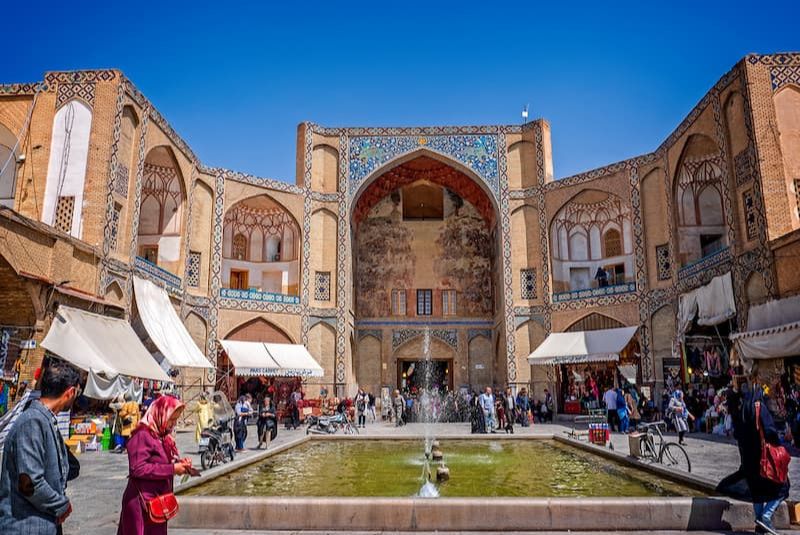
Isfahan's Qaysarieh Bazaar, dating back to the Safavid period (1501-1736 AD) with additions in the Qajar era, is a thriving example of a traditional Iranian marketplace. This 1.5-kilometer long bazaar is known for its beauty and vibrancy. While narrower than some bazaars, it offers a wealth of specialized sections dedicated to various crafts, from coppersmiths and goldsmiths to shoemakers and confectioners. The Isfahan Bazaar remains a vital center of commerce and a popular destination for both shopping and admiring its architectural heritage.
| Also read about: Vank Cathedral in Isfahan
Isfahan Attractions Near Kohneh Square
After visiting Isfahan Kohneh square, make sure to visit nearby attractions:
Naqsh-e Jahan Square

Built under Shah Abbas and inspired by Atiq Square, Naqsh-e Jahan Square boasts a grand scale (560 meters long by 160 meters wide) and is adorned with architectural gems like Ali Qapu Palace, Shah Mosque, Sheikh Lotfollah Mosque, Sardar Qaysariyeh, Polo Gates, historical shops and cells. This square offers something for everyone, from sightseeing and shopping to relaxing carriage rides and picnics.
| Related: Top 10 hotels Nearby Naghsh-e Jahan Square in Isfahan
Ali Qapu Palace
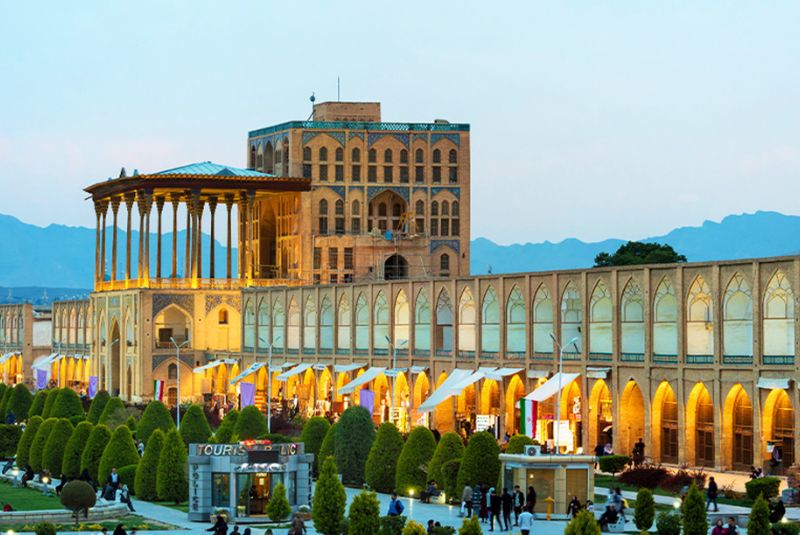
Ali Qapu Palace, inscribed as a UNESCO World Heritage Site, stands tall within Naqsh-e Jahan Square. This six-story structure, reaching nearly 45 meters in height, is connected by three staircases. Its beauty lies in its traditional design, featuring captivating decorations like floral paintings, hunting scene depictions, miniatures, intricate plasterwork, vibrant seven-color tiles, elegant slender lines, and gilded embellishments adorning the walls and arches.
Si-o-Se Pol Bridge

Despite its various names like Shah Abbasi Bridge or Thirty-Three Bridges, this iconic landmark of Isfahan is actually the Si-o-Se Pol Bridge, a 17th-century marvel built by Shah Abbas's general and designed by a renowned architect. With 33 arches on its first level, it's more than just a bridge; it's a bustling space for locals and tourists to relax, socialize, and soak in the historical atmosphere.
| Also read about: Top 5 Bridges in Isfahan over Zayanderud River
Khajoo Bridge
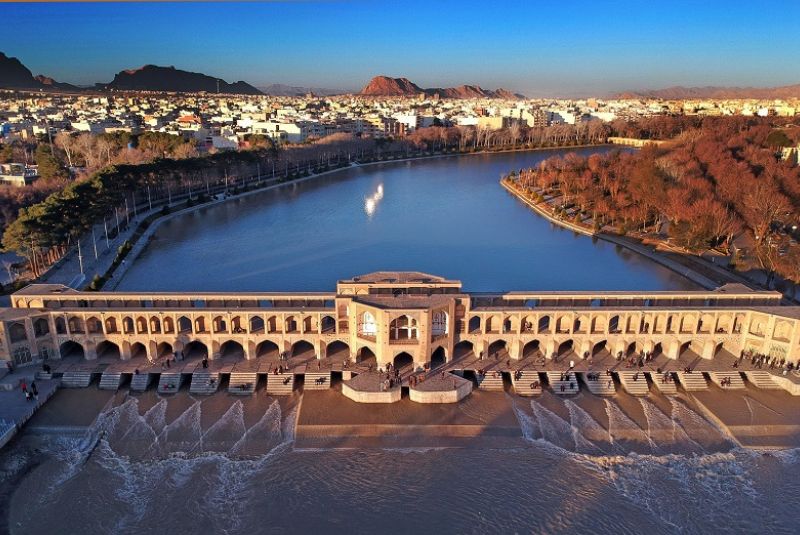
The Khaju Bridge, situated just 1,800 meters east of the Si-o-Se Pol Bridge (Thirty-Three Bridges) on the Zayandeh River, is another architectural gem from Isfahan's Safavid period (1501-1736 AD). Renowned for its unique style, symmetry, and overall beauty, the bridge has garnered various names throughout history, including Hassan Abad Bridge, Shiraz Bridge, Shahi Bridge, and Baba Ruknuddin Bridge. Spanning 133 meters in length, 12 meters in width, and reaching a height of 7.5 meters, the Khaju Bridge stands as a testament to Safavid engineering prowess.
Atiq Square Location and Access
Isfahan Atiq or Kohneh square is located around 2 kilometers north of Isfahan's famous Naqsh-e Jahan Square. If you're feeling energetic, you can walk there in about 19 minutes via Ahmedabad Street and Moshiri Street. While there's no metro station right next to Atiq Square, its proximity to the main square makes it reachable by taxi or other public transportation options.
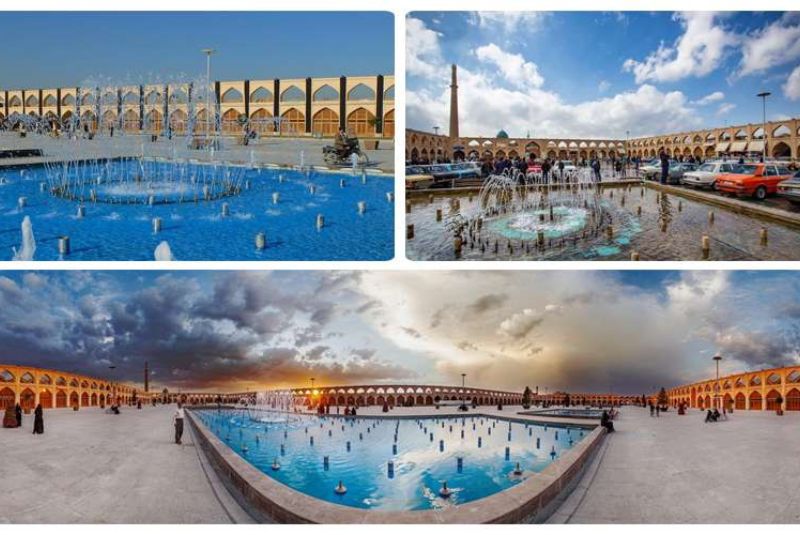
Isfahan's weather can affect your experience at Atiq Square. The cooler autumn and winter months are ideal for appreciating the square's historical ambiance. However, don't rule out a summer visit! During the warmer season, you can enjoy the lively atmosphere and the dancing fountains in the square's center.
| Also might be interesting: Best Dishes in Isfahan You Must Try!
Final Takeaway
If you're exploring the wonders of Isfahan, Iran, don't miss the historical Atiq Square. Its rich past and unique atmosphere offer a captivating complement to Isfahan's other renowned attractions.
Share your story!
Comment below and let us know about your Experience.
Your story inspires others!


Comment
Leave a Comment